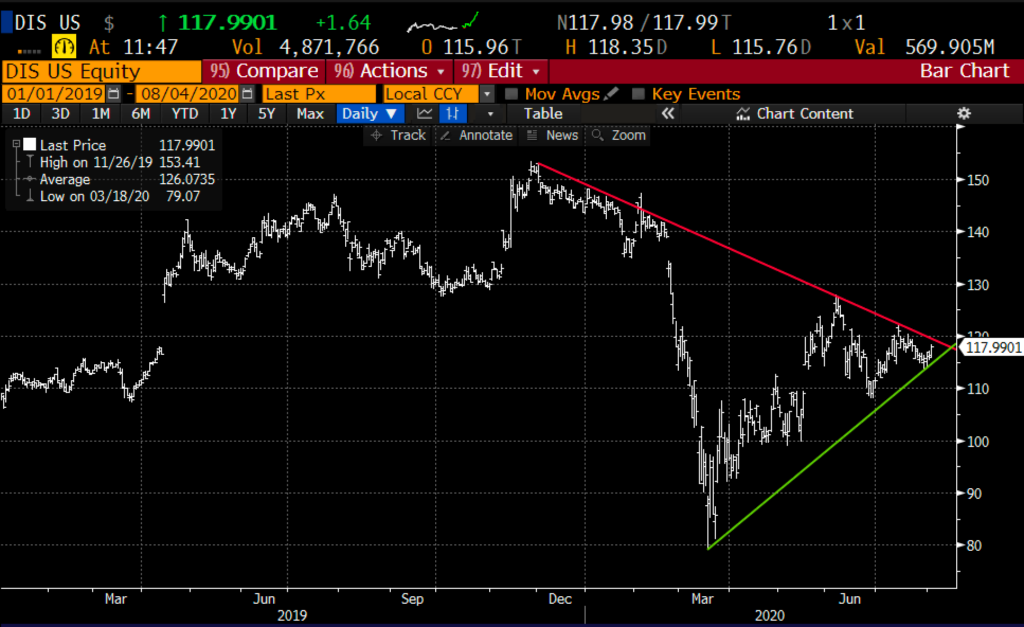Disney (DIS) reports its fiscal Q3 earnings today after the close. The options market is implying about a 5% one day move tomorrow which is double the average over the last four quarters. With the stock just above $118, the Aug 7th weekly 118 straddle (the call premium + the put premium) is offered at $6, if you bought that and thus the implied movement you would need a rally above $124 or a decline below $112 to make money.
Shares of DIS are down 18% on the year, and down 22% from its all-time high made in late November. At its lows, in March the stock was down nearly 50% but has rallied 50% from those levels. From a technical perspective, the stock is very near the height of tension of its recent range of a series of lower lowers and a series of higher highs, it appears poised to break of this wedge it is in one way or the other, and soon:

Wall Street analysts remain relatively mixed on the stock with 17 Buy ratings, 13 Holds, and only 1 Sell. That Sell rating, Rich Greenfield, founder of Lightshed Partners (formerly of BTIG) posted Nine Questions for Disney’s Q3 2020 Earnings Interview Tonight and suggested:
Earnings are expected to be awful, with virtually every part of Disney severely impacted by the COVID-19 pandemic except for Disney+/Hulu, which have been notable beneficiaries. What will be far more important to investors is how management discusses their plans to deal with the unprecedented challenges facing Disney over the coming year(s).
We have been surprised that investors are willing to look through the ongoing pandemic and give Disney credit for returning to 2019 EPS levels, if not higher. The mistake investors are making is that by the time Disney recovers from the pandemic, their earnings power will have materially eroded, leading to a lower base level of revenues than 2019 (tied to broadcast/cable networks and studio entertainment); not to mention the time needed to “recover” in theme parks could be years. Disney+ has been a rocket ship subscriber-wise, surpassing even our far above consensus subscriber expectations (bear in mind, with average ARPU moving toward $5/month, Disney+ quarterly revenue is still sub $1 billion). However, Disney+ alone is not enough reason to own Disney stock at these levels, particularly as leverage moves toward 5x and management refuses to pivot their film and television businesses toward streaming.
Last week on CNBC”s Fast Money, I echoed this sentiment, with so little visibility in their core businesses, and little hope of the coronavirus abating before widespread distribution of a vaccine, and our economy in the throes of the worst recession in a hundred years, it is hard to see how this company can guide in a way that would make investors enthusiastic to buy the shares:
This is the most important chart for the market right now, says @RiskReversal. Here’s his reasoning. $DIS pic.twitter.com/6oF6poEeFF
— CNBC’s Fast Money (@CNBCFastMoney) July 29, 2020
So what’s the trade?
I am obviously not optimistic about the company’s near-term prospects and I don’t think any fast-tracked coronavirus vaccine for this year’s use will be widely adopted, DIS’s outlook will be as clear as mud.
Bearish Trade Idea: DIS ($118) Buy Aug 21st 115 – 100 put spread for $2.35
-Buy to open 1 Aug 115 put for 2.65
-Sell to open 1 Aug 100 put at 30 cents
Break-even on Aug 21st expiration:
Profits of the stock of up to 12.65 between 112.65 and 110 with max gain of 12.65 below 100
Losses of up to 2.35 between 112.65 and 115 with max loss of 2.35 above 115
Rationale: this trade idea risks 2% of the stock price, breaks-even down 4.5% and has a max gain of nearly 11% of the stock price if the stock is down 15% in a little more than two weeks.
OR
If I were inclined to be contrarian I might consider a call spread in Sept, allowing for more time for a move higher to play out and target the March breakdown level near $140:
Bullish Trade Idea: DIS ($118) Buy Sept 120 – 140 call spread for $4
-Buy to open 1 Sept 120 call for 4.50
-Sell to open 1 Sept 140 call at 50 cents
Break-even on Sept expiration:
Profits of up to 16 between 124 and 140 with max gain above 140
Losses of up to 4 between 120 and 124 with max loss of 4 below 120
Rationale: this trade risks 3.4% of the stock price, has a break-even up 5% with a max potential gain of 13.5% of the stock price if it is up 18.5% in a month and a half.